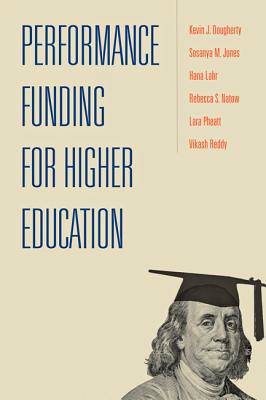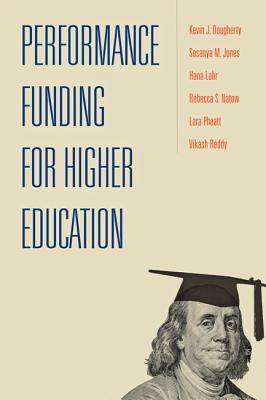
- Retrait gratuit dans votre magasin Club
- 7.000.000 titres dans notre catalogue
- Payer en toute sécurité
- Toujours un magasin près de chez vous
- Retrait gratuit dans votre magasin Club
- 7.000.000 titres dans notre catalogue
- Payer en toute sécurité
- Toujours un magasin près de chez vous
Performance Funding for Higher Education
Kevin J Dougherty, Sosanya Jones, Hana Lahr, Rebecca S Natow, Lara Pheatt, Vikash ReddyDescription
A rigorous analysis of the impact--and implications--of performance funding for higher education.
Seeking greater accountability in higher education, many states have adopted performance funding, tying state financial support of colleges and universities directly to institutional performance based on specific outcomes such as student retention, progression, and graduation. Now in place in over thirty states, performance funding for higher education has been endorsed by the US Department of Education and major funders like the Gates and Lumina foundations. Focusing on three states that are regarded as leaders in the movement--Indiana, Ohio, and Tennessee--Performance Funding for Higher Education presents the findings of a three-year research study on its implementation and impacts.
Written by leading authorities and drawing on extensive interviews with government officials and college and university staff members, this book
describes the policy instruments states use to implement performance funding;
explores the organizational processes colleges rely on to determine how to respond to performance funding;
analyzes the influence of performance funding on institutional policies and programs;
reviews the impacts of performance funding on student outcomes;
examines the obstacles institutions encounter in responding to performance funding demands;
investigates the unintended impacts of performance funding.
The authors conclude that, while performance funding clearly grabs the attention of colleges and leads them to change their policies and practices, it also encounters major obstacles and has unintended impacts. Colleges subject to performance funding are hindered in posting good results by inappropriate performance measures, insufficient organizational infrastructure, and the commitment to enroll many students who are poorly prepared or not interested in degrees. These obstacles help explain why multivariate statistical studies have failed to date to find a significant impact of performance funding on student outcomes, and why colleges are tempted to resort to weakening academic quality and restricting the admission of less-prepared and less-advantaged students in order to improve their apparent performance.
These findings have wide-ranging implications for policy and research. Ultimately, the authors recommend that states create new ways of helping colleges with many at-risk students, define performance indicators and measures better tailored to institutional missions, and improve the capacity of colleges to engage in organizational learning.
Spécifications
Parties prenantes
- Auteur(s) :
- Editeur:
Contenu
- Nombre de pages :
- 276
- Langue:
- Anglais
Caractéristiques
- EAN:
- 9781421420820
- Date de parution :
- 04-10-16
- Format:
- Livre broché
- Format numérique:
- Trade paperback (VS)
- Dimensions :
- 150 mm x 226 mm
- Poids :
- 408 g







